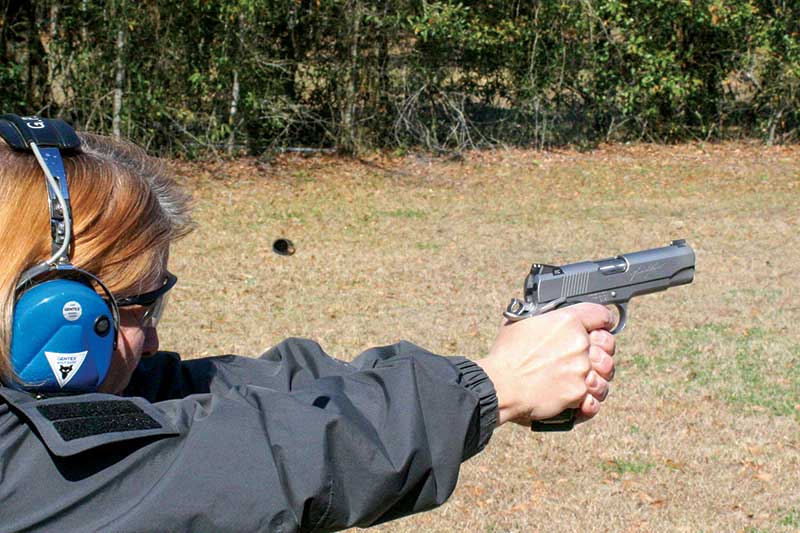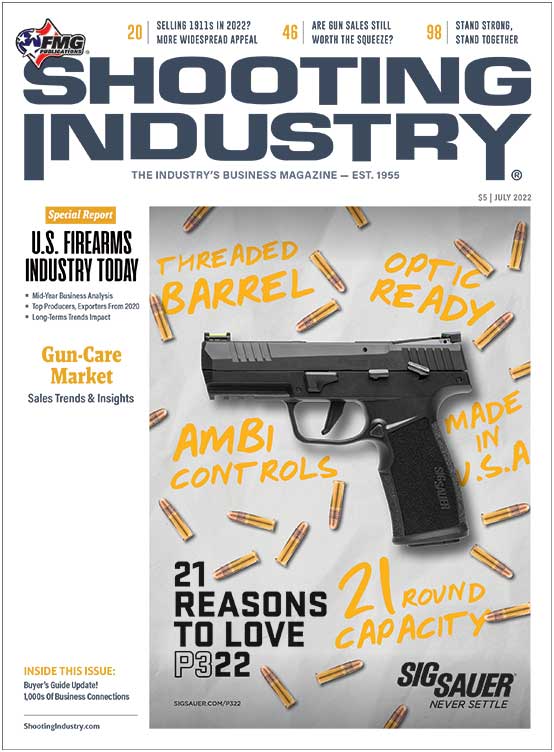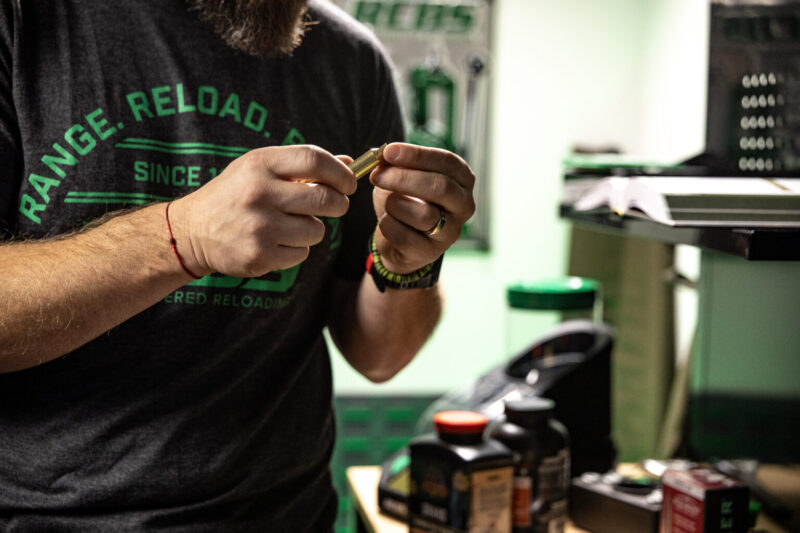Selling The 1911 In 2022
The classic John Moses Browning design finalized in the year 1911 remains a steady seller, if not the best seller, in American gun shops today. There are sound reasons for this.
Logic tells us if customers, particularly those new to firearms, are educated as to these reasons, your gun shop should sell even more 1911s. Let’s make a list.
1911 Selling Points
Slimness: A big 1911 advantage is its svelte features. Whatever the length of barrel or grip frame, a 1911’s thin profile aids concealment and comfort in daily carry. This is particularly true for the customer who wants a more powerful gun, such as the original 1911’s .45 ACP chambering. The comfort factor is even more pronounced when carried IWB.
In 2022, that element of the discussion brings us to a contemporary trend: appendix inside-the-waistband carry (AIWB). This carry method allows carry of a larger pistol because with the height of the gun spread across the front of the abdomen, the pistol lies flatter against the body with less protuberance at the top or butt.
However, anyone who carries appendix is going to be acutely aware the gun is pointed at the private parts and the femoral artery, a fact that has kept many from following the trend.
One can make the argument, due to its mandatory cocked and locked carry, the 1911 is safer for drawing and particularly holstering with this holster location. (1) The thumb can hold the hammer back, preventing it from falling. (2) With the thumb in this position, the 1911’s grip safety is activated so even if the shooter has neglected to lock the thumb safety and something presses the trigger, the pistol still won’t go bang. (3) Finally, of course, the properly engaged thumb safety is another surety against unintentional discharge.
All this can give the customer more peace of mind than a “press trigger and shoot” design, such as most iterations of our most popular striker-fired pistols.
Shootability: The genius of John Browning in the 1911 gave us a pistol amendable to a great many hands. The key element in a handgun’s fit to the hand is trigger reach, the distance from where the web of the hand is located in line with the long bones of the forearm to the chosen point of contact of the index finger on the the trigger. Your showcase can contain 1911s with long triggers, medium-length triggers and the short trigger of the 1911A1 design, one or the other of which will fit the hand of virtually any customer who enters your gun shop.
The sliding, rather than pivoting, trigger of the 1911 makes it easy to apply even pressure to the rear. This is one reason the 1911 remains the overwhelming choice of competitors in precision-pistol shooting, as the bull’s-eye game is called these days.
A 1911 has a relatively low-bore axis, reducing muzzle jump. So long as it has a beavertail grip safety, there will be no hammer bite or slide bite to the web of the hand. Thin grip panels are available, which give even more reach to the trigger and get more of the hand’s flesh and bone wrapped around the grip frame. Those with larger mitts will appreciate hand-filling grip options by Hogue and many others.
Versatility: Ambidextrous thumb safeties adapt the 1911 to left-handed customers. The 1911 is readily available today in calibers from .22 LR through .22 TCM, .380, 9mm, .40 S&W, 10mm, .50 GI, and — of course — .45 ACP. In addition, .22 conversion units are readily available.
“No thumb safety is more ergonomic than that of the 1911, the standard by which other such designs are judged.”
Women & 1911s
We all know women are an important and growing market in the retail firearms world. Consider the 1911A1 pistol, with its short trigger and the now universally standard finger niches at the back of the trigger guard. (This was adapted roughly a century ago to fit soldiers with smaller hands, at a time when American men were shorter in stature with proportionally smaller hands than today’s average.)
This means the 1911 can be a particularly good fit for women, whose average height today is similar to the average man in WWI who complained about the original 1911’s trigger being too long, and for whom the 1911A1 was specifically adapted.
Another market segment is aging customers of either gender who have trouble retracting slides. We now have a whole genre of pistols, typified by the Smith & Wesson EZ series, expressly designed for easy trigger manipulation. The 1911 has had this all along. Simply show the customer how to use the thumb or heel of the support hand to cock the 1911’s hammer; now the mainspring is no longer holding the slide forward via the hammer, and the shooter has only the resistance of the recoil spring to contend with. Easy peasy.
The Manual Safety Advantage
Although the advantage of a 1911’s cocked and locked carry can be appreciated by either gender, dealers tell me female customers, in particular, are often insistent on a manual safety when they purchase a semi-auto pistol for self-defense.
No thumb safety is more ergonomic than that of the 1911, the standard by which other such designs are judged.
Generations of women have been told “Don’t carry a gun, the rapist will just take it away from you and use it against you.” A pistol with a manual safety is one more insurance policy against that happening.
Here’s why: In the late 1970s, I did a survey of a large state police agency, which by then had issued a semi-auto pistol with manual safety for a decade. I was able to identify 13 troopers who were alive because of that gun and probably would have been killed had they been armed with the previous service revolver. Only four could be attributed to the new gun holding more than six rounds.
More of those “saves” came from the thumb safety than anything else, when a stronger criminal got their gun away from them, tried to shoot them with it and couldn’t because they weren’t able to find the safety catch to “turn on the gun.”
A test that appeared some 40 years ago in Police Chief magazine attempted to replicate this. The ordinary people (not gun-trained cops) in the study were able to pick up a service revolver and fire it in an average time of just over one second; the same would be true today with a point-and-shoot autoloader. However, the cocked and locked Colt .45 Auto in the study took those people an average of 17 to 18 seconds to figure out how to off-safe and get off a shot! You might want to remind the customer, in 17 seconds, they can do many unpleasant things to their attacker or run a considerable distance.
“Whatever the length of barrel or grip frame, a 1911’s thin profile aids concealment and comfort in daily carry.”
Stopping Power Considerations
Finally, bear in mind the 1911 in the currently popular 9mm chambering is incredibly easy to shoot in terms of recoil, a particular selling point with “gals and geezers.” Today’s 9mm ammo is generally recognized as adequate in “stopping power.”
From functional lower-priced models like Springfield Armory’s Mil-Spec or the Armscor pistols, to multi-thousand dollar factory custom marques such as Wilson Combat, Ed Brown, Nighthawk and Les Baer, you can adapt to a wide range of customers’ wallets like an automobile dealer who carries both Chevrolet and Cadillac.
From the Chevy end to the Caddy end, a shelf of 1911s in your showcase will continue to appeal to a broad spectrum of purchasers.






